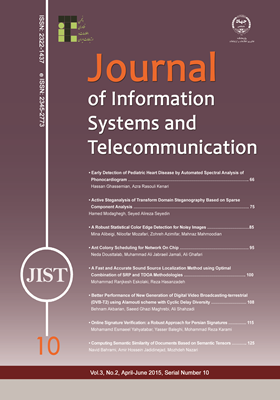-
-
List of Articles
-
Open Access Article
1 - Early Detection of Pediatric Heart Disease by Automated Spectral Analysis of Phonocardiogram
Azra Rasouli Kenari -
Open Access Article
2 - Active Steganalysis of Transform Domain Steganography Based on Sparse Component Analysis
Hamed Modaghegh Seyed Alireza Seyedin -
Open Access Article
3 - A Robust Statistical Color Edge Detection for Noisy Images
Mina Alibeigi Niloofar Mozafari Zohre Azimifar Mahnaz Mahmoodian -
Open Access Article
4 - Ant Colony Scheduling for Network On Chip
Neda Dousttalab Mohammad Ali Jabraeil Jamali Ali Ghaffari -
Open Access Article
5 - A Fast and Accurate Sound Source Localization Method using Optimal Combination of SRP and TDOA Methodologies
Mohammad Ranjkesh Eskolaki Reza Hasanzadeh -
Open Access Article
6 - Better Performance of New Generation of Digital Video Broadcasting-terrestrial (DVB-T2) Using Alamouti scheme with Cyclic Delay Diversity
Behnam Akbarian Saeed Ghazi-Maghrebi -
Open Access Article
7 - Online Signature Verification: a Robust Approach for Persian Signatures
Mohamamd Esmaeel Yahyatabar Yasser Baleghi Mohammad Reza Karami-Mollaei -
Open Access Article
8 - Computing Semantic Similarity of Documents Based on Semantic Tensors
Navid Bahrami Amir H. Jadidinejad Mojdeh Nazari
-
The rights to this website are owned by the Raimag Press Management System.
Copyright © 2017-2024







